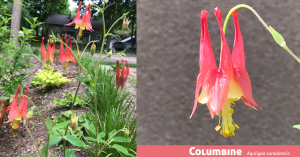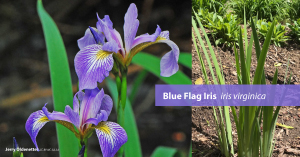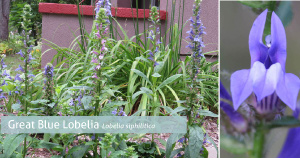Here are four of my favorite native plants that work well in rain gardens. However, if you don’t have a rain garden you can still plant natives that are a good match for your conditions. By planting perennials, you’ll get to greet them every spring when they return.
It was hard to choose my favorites– I am planting more varieties each year but these plants are in my rain garden and they come back every year. I know they work in our area. Plus, I love their blooms.

This Columbine (Aquligea canadensis) is a delightfully delicate woodland flower that is perfect for a shady spot in your garden. It grows 2-3 feet and blooms in May. 
Next up is the Blue Flag Iris (Iris virginica), chosen for its beauty and ability to tolerate a lot of water. Growing 2-3 feet tall with neat, upright stalks, it can be planted in the sun or part sun. It is considered a “workhorse” in a rain garden and can be planted at the lowest point where the water collects.
 The Wild Ginger (Asarum canadense) is a handy ground-dweller with a secret. This native perennial has a lovely flower that it hides under its heart shaped leaves. This short plant grows to about 6 inches tall and is happiest in shady places.
The Wild Ginger (Asarum canadense) is a handy ground-dweller with a secret. This native perennial has a lovely flower that it hides under its heart shaped leaves. This short plant grows to about 6 inches tall and is happiest in shady places.
 The Great Blue Lobelia (Lobelia siphilitica) is a delightful perennial that does well in sun, part sun and shade. It grows 2-3 feet tall with upright, tidy stalks. The delicate flowers show up later (July-Sept) so plant near a mid-early bloomer to keep flowers going in your space.
The Great Blue Lobelia (Lobelia siphilitica) is a delightful perennial that does well in sun, part sun and shade. It grows 2-3 feet tall with upright, tidy stalks. The delicate flowers show up later (July-Sept) so plant near a mid-early bloomer to keep flowers going in your space.
I learned about all these plants through the Washtenaw County’s Rain Garden program. Although I took the class and put in a rain garden, I use their resources for other areas in my yard too. Each year I am adding more and more natives using their detailed plant list and resources for finding native plants. Your don’t need to have a rain garden for the plants on their list. Just follow the guidelines for sun and soil conditions (they give details on each plant) then you can take it from there. To find sources of plants, check out the Michigan Native Plant Producers Association’s list of member nurseries.
By planting natives, you are creating habitat for wildlife with plants that are easier and less expensive to maintain. Here are some more tips from our site and more tips from Oakland County. Happy planting!



